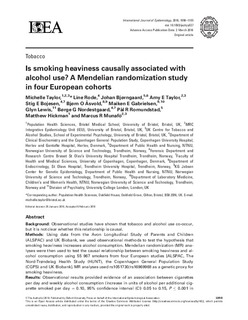| dc.contributor.author | Taylor, Michelle | |
| dc.contributor.author | Rode, Line | |
| dc.contributor.author | Bjørngaard, Johan Håkon | |
| dc.contributor.author | Taylor, Amy E. | |
| dc.contributor.author | Bojesen, Stig E. | |
| dc.contributor.author | Åsvold, Bjørn Olav | |
| dc.contributor.author | Gabrielsen, Maiken Elvestad | |
| dc.contributor.author | Lewis, Glyn | |
| dc.contributor.author | Nordestgaard, Børge G. | |
| dc.contributor.author | Romundstad, Pål Richard | |
| dc.contributor.author | Hickman, Matthew | |
| dc.contributor.author | Munafò, Marcus R. | |
| dc.date.accessioned | 2019-03-05T08:19:52Z | |
| dc.date.available | 2019-03-05T08:19:52Z | |
| dc.date.created | 2018-12-25T14:16:08Z | |
| dc.date.issued | 2018 | |
| dc.identifier.citation | International Journal of Epidemiology. 2018, 47 (4), 1098-1105. | nb_NO |
| dc.identifier.issn | 0300-5771 | |
| dc.identifier.uri | http://hdl.handle.net/11250/2588644 | |
| dc.description.abstract | Background
Observational studies have shown that tobacco and alcohol use co-occur, but it is not clear whether this relationship is causal.
Methods
Using data from the Avon Longitudinal Study of Parents and Children (ALSPAC) and UK Biobank, we used observational methods to test the hypothesis that smoking heaviness increases alcohol consumption. Mendelian randomization (MR) analyses were then used to test the causal relationship between smoking heaviness and alcohol consumption using 55 967 smokers from four European studies [ALSPAC, The Nord-Trøndelag Health Study (HUNT), the Copenhagen General Population Study (CGPS) and UK Biobank]. MR analyses used rs1051730/rs16969968 as a genetic proxy for smoking heaviness.
Results
Observational results provided evidence of an association between cigarettes per day and weekly alcohol consumption (increase in units of alcohol per additional cigarette smoked per day = 0.10, 95% confidence interval (CI) 0.05 to 0.15, P ≤ 0.001 in ALSPAC; and 0.48, 95% CI 0.45 to 0.52, P ≤ 0.001 in UK Biobank). However, there was little evidence for an association between rs1051730/rs16969968 and units of alcohol consumed per week across ALSPAC, HUNT, CGPS and UK Biobank (standard deviation increase in units of alcohol per additional copy of the risk allele = –0.004, 95% CI –0.023 to 0.016, P=0.708, I2 = 51.9%). We had 99% and 88% power to detect a change of 0.03 and 0.02 standard deviation units of alcohol per additional copy of the risk allele, respectively.
Conclusions
Previously reported associations between smoking and alcohol are unlikely to be causal, and may be the result of confounding and/or reverse causation. This has implications for public health research and intervention research. | nb_NO |
| dc.language.iso | eng | nb_NO |
| dc.publisher | Oxford University Press | nb_NO |
| dc.relation.uri | https://www.ncbi.nlm.nih.gov/pmc/articles/PMC6124618/ | |
| dc.rights | Navngivelse 4.0 Internasjonal | * |
| dc.rights.uri | http://creativecommons.org/licenses/by/4.0/deed.no | * |
| dc.title | Is smoking heaviness causally associated with alcohol use? A Mendelian randomization study in four European cohorts | nb_NO |
| dc.type | Journal article | nb_NO |
| dc.type | Peer reviewed | nb_NO |
| dc.description.version | publishedVersion | nb_NO |
| dc.source.pagenumber | 1098-1105 | nb_NO |
| dc.source.volume | 47 | nb_NO |
| dc.source.journal | International Journal of Epidemiology | nb_NO |
| dc.source.issue | 4 | nb_NO |
| dc.identifier.doi | 10.1093/ije/dyy027 | |
| dc.identifier.cristin | 1647101 | |
| dc.description.localcode | Copyright The Author(s) 2018. Published by Oxford University Press on behalf of the International Epidemiological Association. This is an Open Access article distributed under the terms of the Creative Commons Attribution License (http://creativecommons.org/licenses/by/4.0/) | nb_NO |
| cristin.unitcode | 194,65,20,0 | |
| cristin.unitname | Institutt for samfunnsmedisin og sykepleie | |
| cristin.ispublished | true | |
| cristin.fulltext | original | |
| cristin.qualitycode | 2 | |

